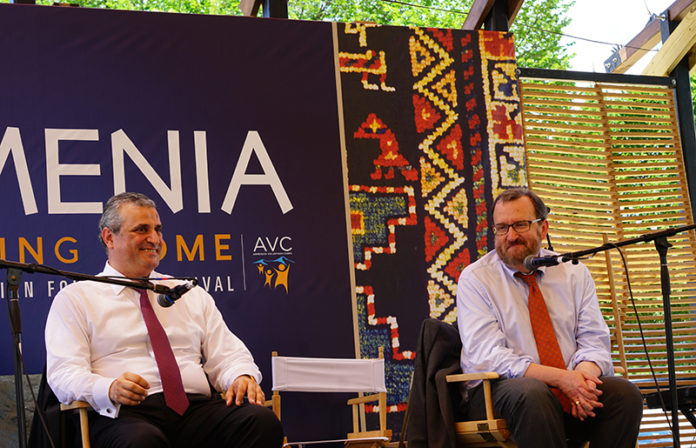WASHINGTON – The results of cultural diplomacy and American efforts in Armenia are often encountered, but it is rare to hear diplomats publicly define and discuss this oft ambiguous tool of governments. The Smithsonian Folklife Festival, this year dedicated to the cultures of Armenia and Catalonia, gave the public a glimpse of the thinking of two ambassadors on this topic. Armenia’s ambassador to the United States Grigor Hovhannisian, and America’s ambassador to Armenia, Richard M. Mills, Jr., participated on June 28 at a special program of the festival, “Cultural Diplomacy with Two Ambassadors,” held at the Hyurasenyak pavilion at the Washington Mall. Jay Ramen, director of the Cultural Programs Division of the Bureau of Educational and Cultural Affairs at the US Department of State, served as moderator.

Hovhannisian, born in 1971 in Yerevan, Armenia, studied Arab and Oriental Studies at Yerevan State University, and did graduate work at Haigazian University in Beirut before earning a master’s degree in 2001 from the Fletcher School of Law and Diplomacy of Tufts University in Massachusetts. He worked for the United Nations (UN) in Armenia, several African countries and Lebanon, and after joining Armenia’s Foreign Service, became Armenia’s consul general in Los Angeles in 2009, ambassador to Mexico in 2014, and since 2016, ambassador to the US.

Mills, born 1959 in Louisiana, received a B.A. from Georgetown University, a J.D. from the University of Texas School of Law, and an M.S. in National Security Strategy from the National Defense University. He worked as an attorney in Washington prior to entering the US Foreign Service. He has served as a diplomat in France, Russia, Ireland, Pakistan, Malta and at the UN. Before becoming ambassador to Armenia in 2015, he most recently was deputy chief of mission at the US embassy in Beirut, Lebanon from 2012 to 2014.
Ramen started off the conversation between the two ambassadors by asking what cultural diplomacy is and how it fits into their work as ambassadors.
Mills first declared that it is not handing out copies of books like Moby Dick or Little Women to people around the world, since people can in today’s globalized environment easily have access to American culture directly. He said, “I think it kind of sells itself.”
There are, however, two ways in which the US embassy uses American culture in its work, according to Mills. First, it can be used to promote goals or values. He gave the example of promoting understanding of the rights of the disabled. A grant from Ramen’s Bureau allowed the translation of a book into Armenian called Wonder, which is about a young boy facing life with a facial deformity. The embassy distributed it to schools in Armenia, brought in school children to talk about the book, and developed a curriculum that school teachers could use to talk about this book in their schools. This was a use of culture to promote a reform or value in Armenia, which the Armenian government also supported.










